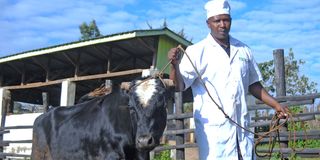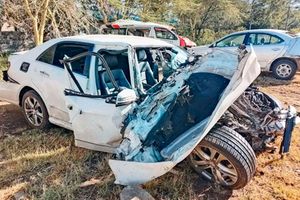Premium
To trade in cattle this festive season, here is all the information you need

John Muthui, a butchery owner in Elburgon, Nakuru County, leads a bull to a slaughterhouse.
What you need to know:
- Transporters, herders, county officials and brokers (cartels) are among people one has to deal with in a long chain of actors before the meat reaches consumers
- The pastoral communities sell bulls and non-performing females. One can buy them directly from the farmers, in the grazing fields or at watering points.
- Tertiary markets, on the other hand, are at slaughter premises far away from the production areas in places such as Mombasa and Nairobi.
- Tertiary markets in Nairobi include Dagoretti and Dandora (Njiru), which receive animals coming from secondary markets in North Eastern, Nyanza, Rift Valley and Eastern provinces.
As the festive season approaches, you may want to make some money by engaging in cattle trade since meat is one of the widely consumed products during the period. Prices also rise as demand surges, giving traders good profits.
But do you know what it takes to have the animals reach the market and the meat on consumers’ plates?
To start with, about 80-90 per cent of the red meat consumed in Kenya comes from livestock reared in pastoral communities across the country and neighbours Ethiopia, Uganda, Tanzania and Somalia, 2 per cent comes from ranches and the rest is from the high potential areas.
The pastoral communities sell bulls and non-performing females. One can buy them directly from the farmers, in the grazing fields or at watering points.
The animals can also be sourced from markets that are tiered into primary, secondary and tertiary. Primary markets are in the rural areas while the secondary are in the urban centres of the arid and semi-arid areas such Garissa, Wajir, Marsabit, Kajiado, Mwingi and Isiolo.
Tertiary markets, on the other hand, are at slaughter premises far away from the production areas in places such as Mombasa and Nairobi.
Buyers at the primary markets are individuals with limited capital who buy a few animals from the villages and trek with them to the secondary markets or to butchers.
On the other hand, those from the secondary markets are individuals, groups or companies with big sums of money who buy many animals and either trek them to the tertiary markets slowly as they gain weight, sometimes resting them in hired ranches for fattening or awaiting market opportunities or sometimes hiring transport.
Individually, company or cooperative-owned ranches sell mostly herds of animals to targeted markets where in most cases they have contractual agreements, though one can also approach them.
Some ranches also have feedlot systems that fatten cattle using high-energy-concentrate feeds. The high potential areas are the highlands of Kenya where they sell dairy and cross-breed bulls and culled females for meat.
Market for the animals
Meat consumption takes place in both rural and urban town centres. Small-scale traders from primary markets target the rural shopping centres while large-scale traders from secondary markets target major urban areas, with Nairobi and Mombasa being the key terminal markets for meat, accounting for 75 per cent of the country’s consumption.
Nairobi’s high consumption is due to its huge human population and high economic status for some of its population. In addition to these factors, Mombasa is a tourist destination with visitors who are well-off.
Tertiary markets in Nairobi include Dagoretti and Dandora (Njiru), which receive animals coming from secondary markets in North Eastern, Nyanza, Rift Valley and Eastern provinces.

Traders restrain cattle for sale at Nguni market in Mwingi East sub-county, Kitui County, in August. Some animals are sold through an auction.
Mombasa gets animals from the same geographical areas as Nairobi, in addition to Tana River and several ranches at the Coast.
Consumer meat preferences
Consumers in villages and small towns are mainly low-income earners, thus the cost of meat is of great concern to them.
So high-quality meat that attracts premium prices might not be a good choice for this area. Middle-income earners are to be found in the neighbourhoods of secondary markets and meat quality is an important aspect to them, while the high-income earners are located in the major urban centres and cities where premium cuts are preferred.
Ranches and feedlot system produce animals that are suitable for the higher earners.
Other stakeholders in the business
There are several. First, we have middlemen who assist in linking buyers to sellers and for a newcomer in the trade, this category of value-chain actors is essential.
Second, we have transporters who own vehicles for hire and who are key if one needs to move the animals by vehicle.
Third, there are people available for hire who drive animals from one market to another and lastly, county governments not only own most livestock markets but also issue animal transport documents through the veterinary department. They also charge cess and other fees.
Legal requirements/fees/licences
The Meat Control Act Cap 356 and the Animal Disease Act Cap 364 have most of the information on livestock trade.
However, since devolution took effect, trade licences were decentralised, with each county having its own list of licences and fees but the charges do not vary much from one county to another.
To be a livestock trader, one requires to be registered and must possess a trader’s licence, which is free in some counties.
To move animals from one county to another, one requires a “no objection chit” to confirm the absence of notifiable diseases in the destination county.
A movement permit to accompany the animals from the county of animal origin is mandatory. It comes with a small fee per animal depending on species, for example, one county charges Sh100 per head for cattle and Sh30 per head for sheep/goat.
For animals to enter or leave a market/auction yard, a small fee is paid and to leave a county, there is cess (tax) to be paid. Despite the many charges, studies have shown that livestock traders earn a good income.
Challenges
Like in any other business, there are teething problems and operating challenges in livestock trade. These include huge capital since animals are expensive and poor infrastructure, as bad terrain might force one to trek with animals in areas where a vehicle would be more convenient.
Most vehicles are not specifically designed for animal transport and losses and injuries occur in some instances.
A newcomer into the business might require the services of brokers who eat into the profits. Insecurity and cattle rustling are also common in the Asals and one may find cartels in some areas, thus a person who is not from the locality might require an introduction into the business community.
Some counties have strict movement regulations, such as a requirement to move animals during the day only (6am to 6pm).
Other challenges include the migratory nature of pastoral livestock producers, notifiable diseases that lead to closure of markets at times, droughts that decimate animals, inadequate market information and feeding, watering and resting animals when trekking long distances.
****
Drylands
- Kenya’s livestock sector is dominated by smallholders.
- The livestock population is concentrated in arid and semi-arid lands, which cover about 75 per cent of the total land surface.
- In drylands, the livestock sector accounts for 90 per cent of employment and more than 95 per cent of family incomes.





